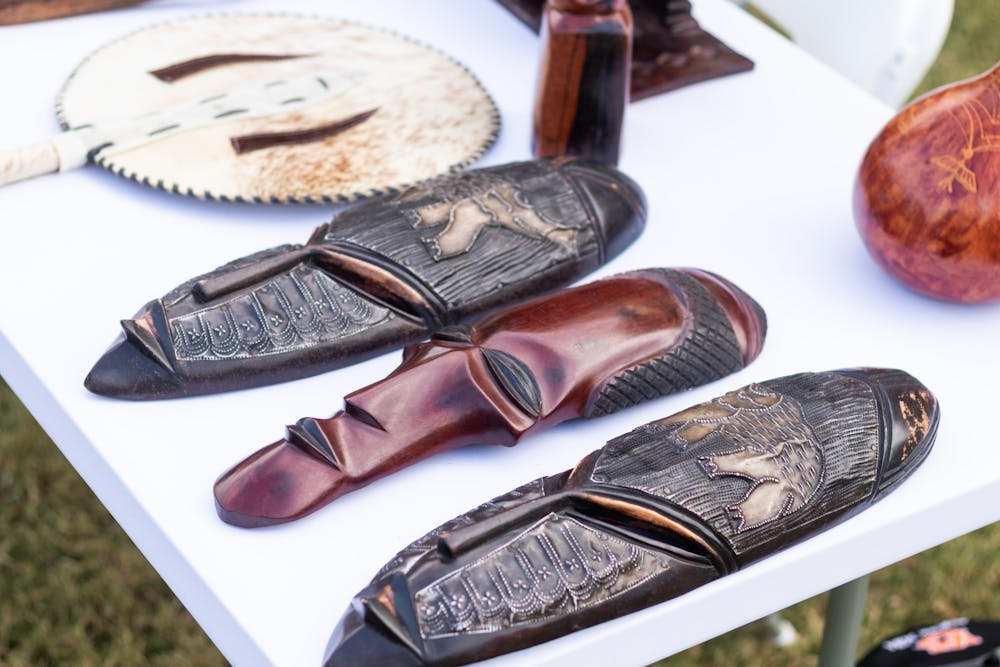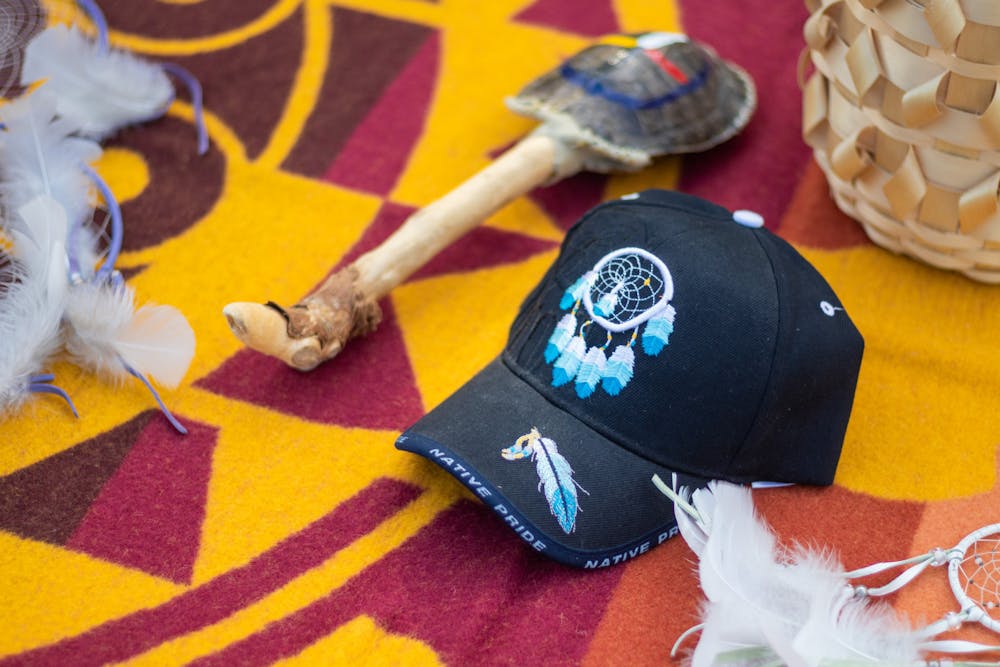Today, Oct. 14 is Indigenous Peoples' Day, which falls on the second Monday of October. The holiday is to celebrate and promote Native American history and culture. In 2021, Pres. Joe Biden proclaimed Indigenous Peoples' Day through formal recognition.
Indigenous Peoples' Day falls on the same day as the federal holiday, Columbus Day. Columbus Day celebrates the anniversary of Italian explorer, Christopher Columbus, reaching the Americas in 1492. Columbus is regarded as the man who introduced the European countries to the Americas, which led to the land's Western colonization.
Recently, the Native American and Indigenous Alliance hosted a cultural immersion event on Cater Lawn. The event was held as a part of the First 56, a student organization that hosts events the first 56 days of the school year.
The event took place on Thursday, Oct. 3, and highlighted several Native American and Indigenous groups, such as the Mississippi Choctaw, and featured speakers there representing Mayan Indians and Indigenous Africans.
Tables were set up along the perimeter of Cater Lawn, showcasing Native American and Mayan artifacts and informational pamphlets dedicated to the Mckenney and Hall Portrait Gallery’s Creek Treaty Delegation to Washington, provided by the Caroline Marshall Draughon Center for the Arts and Humanities.


The Native American and Indigenous Alliance is new to Auburn University, officially founded just recently in March of 2024. The cultural immersion event held Thursday was their first event on campus.
Emily Day, president of Auburn University’s Native American and Indigenous Alliance, started the event with a small speech before giving the floor to the Mississippi Band of Choctaw Indians dance group, the Conehatta Social Group, where they first performed the Four-Step War Dance and the Duck Dance.
The Four-Step War Dance was originally performed in the rare times that war seemed imminent. It was performed within the eight days prior to battle. The circular motion and the four steps of the dance symbolize the cycle of life: birth, growth, decline and death.
The Duck Dance is one of the animal dances of the Choctaw, created to recognize the duck’s contributions to the Choctaw, as they used their feathers, meat and bones. Dancers mimic the duck’s behavior in the dance by shuffling their feet and imitating its walk.
The Conehatta Social Group group were dressed in full traditional regalia, showing off their cultural heritage. The dancers were all between the ages of 3-24, while the adults of the group chanted.

Dr. Mark Wilson, director at the Caroline Marshall Draughon Center for the Arts and Humanities, introduced attendees to Danielle Fixico, a Chickasaw, Muscogee, and Choctaw artist from Morris, Oklahoma and an instructor at the College of the Muscogee Nation, before she took the podium herself.
She started off her speech by introducing herself in each of her three tribal languages and then spoke of her focus while earning her Masters in Fine Arts in college being on Missing and Murdered Indigenous Women.
“Missing and Murdered Indigenous Women, or MMIW, raises awareness for the increased levels of violence that indigenous women face… We need people that are native and non-native [Americans] to know about this issue if we’re really going to bring about change,” Fixico said.
Fixico further elaborates how serious this issue is, explaining, “So when we look at these increased levels of violence that our indigenous women are facing, an indigenous woman is ten times more likely to be murdered than a woman of any other race.” According to Fixico, three out of every five indigenous women will face violence within their lifetime.
“While that’s very shocking, in the conversations that I’ve been having with all the native women that I’ve been talking to, it’s very hard to find a native woman that doesn’t have a story… and that’s how prevalent this issue is within our community,” Fixico said.
At the conclusion of her speech, she informed attendees to stop by her table and grab one of her Missing and Murdered Indigenous Women stickers.
“I’ve been passing out stickers that I created while working on my master’s thesis… It is a red butterfly, as red is the color that we use to bring awareness to MMIW, as it is believed to be the only color that spirits can see when they go to the other side. So by using this color in our MMIW advocacy, we’re calling the spirits of our missing and murdered women back home.”
She explains MMIW’s symbol is typically a red handprint, but for her work, she chose to use a butterfly because it is a symbol for change, which is “really what MMIW is calling awareness for.” She also provided orange butterfly stickers, which raises awareness for Native American boarding schools, another issue the community is facing.
Fixico then gave the floor to the Conehatta Social Group again to perform the Stealing Partners Dance and the Jump Dance.
The Stealing Partners Dance enables each dancer to choose as many partners as he or she would like. Since all dancers are equally able to choose, this dance involves many changes in partners. They also stole members of the audience, bringing almost all attendees into the dance. This dance concludes with the joyful Jump Dance, where the dancers are connected in a large circle, oscillating and jumping to the song.
Celina Aleman, a senior at Auburn and a member of NAIA, then took the podium and introduced the event’s attendees to her younger sister and father, Louis Aleman, a native, practicing Mayan Indian from El Salvador.
El Salvador is located in the center of North America and South America in a very narrow stretch, which is partially why there is so much indigenous history there. “That’s where a lot of different tribes came across,” Aleman explained. “They were very connected to astronomy, and they made the Mayan calendar and respected the moon and the stars.”
Aleman stated that he believes that “like every tribe and every nation that is represented here, we also have that history that we are carrying and that [contains] the hardest times we have had to carry [our history] through. As far as the Mayans in Central America, they’re still pretty active in Guatemala. There are 31 different nations and 31 different dialects still present. And in the lower part of Mexico [contains] many of them as well.”
He grew up knowing he was Native American but wasn’t experienced due to the history of El Salvador’s Indigenous communities being persecuted. He was glad that here he is able to share his culture and ancestry with others. “I’m grateful that I’m part of this ceremony today and this beginning of something beautiful. I think it is all about loving each other and respecting each other.”
Celina Aleman concluded his speech, highlighting the Mayan artifacts he had collected over the years and informed attendees to visit their table after the event to learn about each of them.
The president of Auburn’s African Students Association, Opeyemi Joseph Awotunde, then spoke, leading students and attendees in claps before introducing himself and his reasoning for being there.
“There is a lot of history that connects us if we think deeply about where we’ve been and also where our ancestors have been. [Harrell] played the sound of the drum earlier on, and … it’s also significant in every other culture… the drum is very unique and it’s in each part of our cultures.”
Awotunde spoke more about the similarities between their cultures and how important unity between them was before imparting with “We are not carriers of survival traits alone. We are also carriers of legacy.”
The Conehatta Social Group led the crowd through two final dances, the Racoon Dance and the Walk Dance, before Dr. Joan Harrell, Director of Strategic Initiatives and Programs in the Office of the Dean for the College of Liberal Arts, gave her closing remarks.
Harrell gathered all participating members in front of the podium for her speech. “I would like everyone to take a look. Also, take a look at your hands, everyone in the audience,” Harrell instructed. “Look at yourselves. And look at members of the human community who are standing here, representing each of us.”
She finished by stating, “As we go forth, please remember that, first and foremost, life is sacred. That this is a historic, sacred moment here at Auburn University. As we move forward, we can remember that we literally witnessed the universal meaning of love, which crosses all cultures and languages.”
After the event had ended, Emily Day and her fellow student NAIA members had a few things to say about the event.
“I want people to know that Native American and Indigenous groups are still here, [even though] they only make up 2% of the population of the US.” Day explained. Despite this, according to Day, there is still a deep history of Native Americans in Alabama.
“We’re going to have more events, we’re going to be out here and we just want people to learn and just be open to experiencing the culture,” said Day. “We really want to work together with other student groups on campus just to bring unity because our country is really divided right now, and we just really want to bring people together with love and sharing knowledge… I think it’s just a beautiful picture of humanity.”
Alyssa Martinez, a member of NAIA, responded when asked what her favorite part of the event was. “Just how historic this is, and there’s nothing like this here on campus [until now] and I’m just super proud of Emily for all of her hard work… just seeing everyone come together is really special.”
Many members of NAIA had a lot to say about the important things to learn from this event. “I think that anyone can support this non-profit,” said Molly MacCaughelty. “You don’t have to be indigenous or native to be involved… what we’re trying to do is involve everyone because everyone should know about this, not just natives. We exist to support them… So anyone of any [background] is welcome to become a part of this.”
MacCaughelty highlighted that, “[We] need more advocacy on campus… There’s only, like, 90 indigenous college students [at Auburn] right now.”
”It’s so important to know that native is different,” said Aaron Aldaz. “You can’t just say ‘I know what native looks like.’ There is beauty in looking at many different shades of skin color… There’s a lot of people who struggle with feeling like they can belong to this community and I feel like bringing awareness to the fact that nobody looks [the same], like the part where Harrell said ‘look at your hands.’ Really, to me, it meant ‘look at yourself and know that you are still a part of this,’ even though we all look different from one another.”
The Native American and Indigenous Alliance plan to host more events during Native American Heritage Month, in November.
Do you like this story? The Plainsman doesn't accept money from tuition or student fees, and we don't charge a subscription fee. But you can donate to support The Plainsman.





